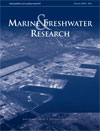Marine and Freshwater Research
Volume 65
Number 10 2014
Allometric relationships and condition factor are important for biological and ecological processes and fisheries assessments. The present study revealed that Macrobrachium vollenhovenii exhibited overall negative allometry and the condition factor decreased from the eastern to western Côte d’Ivoire. These results form a biological database for use by fishery managers and in further research on the ecology and biology of this species.
Mediterranean wetlands are among the most threatened ecosystems worldwide so finding strategies to ensure their conservation is urgent. This work applies a methodology for selecting priority conservation wetlands based on zooplankton community. The results confirm that generating a specific wetland protection network based on zooplankton assemblages is essential for ensuring biodiversity at regional level.
The present study is the first comprehensive overview of the physical and chemical properties of lakes in eastern Australia, extending from the tropics to Tasmania. The results showed that climate is the dominant control on the lakes. The results suggested that high nutrient concentrations in lakes in drier areas may be the result of natural processes of concentrating nutrients, rather than due to human activities.
Overfishing has impacted high-trophic-level fish species, which has been illustrated by calculating the ‘mean trophic level’ of fisheries catches. The mean trophic level of southern Australian fisheries, from 1936 to 2010, declined at a rate greater than the global average but because of increased catches of low-trophic-level species, particularly sardine. These calculations must be interpreted carefully because patterns do not always reflect overfishing.
Fourier transform-near infrared spectroscopy is assessed as a rapid method of ageing Saddletail snapper (Lutjanus malabaricus) using whole dried otoliths. This study developed predictive models for estimating age. Results over two seasons show the method has great potential as a robust fish ageing tool to assist with age-structured stock assessments and sustainable fisheries management. The reduction in costs and time required to age fish will be a substantial benefit.
There is a lack of studies on early-life-history traits in intertidal fishes that recruit to rocky pools. Consequently, the present study revealed the planktonic duration in 14 species of intertidal fishes from the south-eastern Pacific Ocean. A lengthy and variable duration of the pre-settlement phase (45–135 days) seems to be a mechanism through which these fishes may increase their probability to settle in exposed rocky pools.
Species that are able to reproduce multiple times need to recover the energy invested in reproduction before subsequent attempts. Here we test how detritus quality (alder, eucalypt and oak leaf litter) affects the consumption, growth, survival and body condition recovery of a reproducing freshwater invertebrate. We show that only nitrogen- and phosphorus-rich alder enables the recovery of the energy invested in reproduction.
The development of human activities increases pressure on wetland ecosystems, altering plant communities and threatening their biodiversity. Using a set of 32 temporary ponds in northern Morocco we found that most activities were correlated with a loss of rare pond species. The conservation of these species should rely upon networks of the best preserved ponds, while allowing only low-impact activities.
Mangroves are recognised as ecosystems that support critical ecological functions but are threatened by global change. Understanding threats to mangroves requires better models of what regulates species distributions because existing models are limited in their ability to predict change. Better international collaboration of marine and estuarine ecological research will resolve the complexities of mangroves modelling.
It is widely claimed that the world has lost 50% of its natural wetlands, but without supporting evidence. This review of published reports suggests a much greater loss: as high as 87% since 1700 AD, and with loss during the 20th century occurring almost four times faster than previously. Wetlands are continuing to be converted and lost, particularly rapidly in Asia, and the fate of the world’s remaining wetlands is very uncertain.




